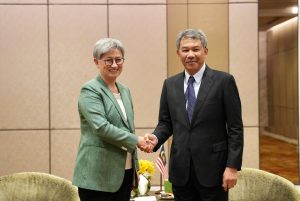On September 11, Malaysia’s government launched the Midterm Review of its first Defense White Paper, which was initially unveiled at the end of 2019. The following day, Malaysia’s Foreign Minister Mohamad Hasan met his Australian counterpart Penny Wong in Melbourne for the 7th Malaysia-Australia Annual Foreign Ministers’ Meeting. They reaffirmed the strength of the bilateral Comprehensive Strategic Partnership, which was established in 2021, and both countries’ commitment to deepening defense ties and mutual support with the aim of maintaining regional security.
These two events, although not directly related, connect the defense of Malaysia and Australia in a unique way.
The Midterm Review reiterated the importance of the three pillars underpinning Malaysia’s defense strategy: concentric deterrence, comprehensive defense, and credible partnerships. This strategic continuity underlines the fact that Malaysia’s strategic context, while ever evolving, has remained constant in key respects, and that the Malaysian Armed Forces (MAF)’s planned capability and capacity building programs remain on track.
Of the three Malaysian defense strategy pillars, the third – credible partnerships – is plausibly the most potent and attainable defensive means for Malaysia in the near and medium terms. The first pillar, concentric deterrence, requires extensive funding to build the capabilities of the MAF. It is envisioned to take more than two more decades to attain an aspired fully modernized joint fighting force between 2050 and 2055. This is translated via the Malaysian Army’s 4NextG modernization plan, the Royal Malaysian Navy’s Plan 15-to-5 transformation program, and the Royal Malaysian Air Force’s CAP55 initiative.
Meanwhile, the second strategic pillar – comprehensive defense – demands a Whole-of-Government-Whole-of-Society approach, which requires political will, policy direction, legislation, and considerable time.
The third pillar – credible partnerships – involves Malaysia’s various existing bilateral and multilateral initiatives such as the Five Power Defense Arrangements (FPDA), ASEAN Defense Ministers Meeting platform, and the United States’ International Military Education and Training program, as well as various other defense diplomacy mechanisms. Compared to the first two pillars, Malaysia’s partnerships offer the readiest means of attaining its defense objectives in the years to come.
This is where last month’s Malaysia-Australia Annual Foreign Ministers’ Meeting enters the picture: Malaysia’s bilateral defense partnership with Australia is perhaps one of its most strategically valuable. Australia’s strategic and defense cooperation with Malaysia has a long history. Australian forces fought against the Japanese military in Malaya during World War II, conducted counterinsurgency operations during the Malayan Emergency (1948-1960), and provided military assistance in defending Malaysia during the Indonesia-Malaysia Konfrontasi (1963-1966). For example, infantry battalions from the Royal Australian Regiment and the Australian Special Air Service Regiment squadrons were deployed to Malaysia during the Konfrontasi.
Australian military units continued their physical presence in Malaysia with the initiation of the FPDA in 1970. Throughout the decades of defense partnership with Australia, Royal Australian Air Force (RAAF) combat aircraft were based at Butterworth, which included CAC Sabres, Dassault Mirage IIIs, and recently, maritime patrol aircraft including the P-8 Poseidon.
Australia also has an infantry unit based in Penang known as the Rifle Company Butterworth. Its tasks are to assist in securing the Butterworth Air Base and conduct joint training with the MAF. The Rifle Company Butterworth celebrates its 55th anniversary of deployment in Malaysia this year. Throughout the five decades of deployment, about 25,000 Australian troops have rotated in and out of Malaysia.
Additionally, under the FPDA platform, an Integrated Area Defense System was established to provide air defense coverage for Peninsular Malaysia and Singapore under the command of an Australian air vice marshal. Since 1981, the RAAF has operated Operation Gateway from Butterworth to conduct maritime surveillance, including the sharing of intelligence collected during these operations with Malaysia. Both countries also have a joint border security program known as Operation Redback, which aims to combat maritime security threats such as people smuggling and human trafficking that affect both countries.
Through another strategic initiative known as the Malaysia-Australia Joint Defense Program (MAJDP), introduced more than 30 years ago, the two countries conduct regular joint military education and training packages and capability building programs, and exchange postings of military officers.
The strategic convergence between Australia and Malaysia has benefited both countries substantially and underlined the importance of Malaysia’s defense strategy of collaborating with credible partners. The presence of Australian troops and air power assets in Malaysia serves as an important deterrent for would-be aggressors. The joint training and cross-posting of military officers in both countries’ defense forces provide important experience and training for both militaries. For Australia, its bilateral defense and security partnerships with Malaysia provides an important geostrategic location for its forward defense bastion strategy.
Moving forward, Australia and Malaysia still have room to deepen strategic ties in building joint capability and capacity building programs in cyber warfare, AI-enabled military technologies, joint warfighting skills, network centric operations, electronic warfare, long-range strike capabilities, maritime surveillance, and layered air defense systems. Developing capacities in these strategic domains will enable Malaysia to gain some valuable know-how about these systems and latest joint warfare practices, and more importantly, how to counter potential adversaries that may use such technologies and warfighting concepts.
With these multiple strategic and defense collaborations, it is surprising that Australia and Malaysia are not formal defense treaty allies. Instead, these two countries cooperate through informal military arrangements via the FPDA platform and the training-capacity-building-oriented MAJDP, aiming for mutual geostrategic benefits. These unique defense and security ties reinforce Malaysia’s foreign policy of neutrality and non-alignment.
In sum, the third pillar of Malaysia’s defense strategy – its credible partnerships with nations like Australia – has yielded the country a handsome strategic dividend. It has enabled Malaysia to attain indirect deterrence against potential foes and gain strategic temporal space for it to build its own concentric deterrence capabilities and operationalize its comprehensive defense measures, while still allowing it to retain its flexibility in its foreign and defense policy orientations. Malaysia’s pursuit of such credible partnerships may well be a compelling example of a middle power’s grand strategy in action.





























